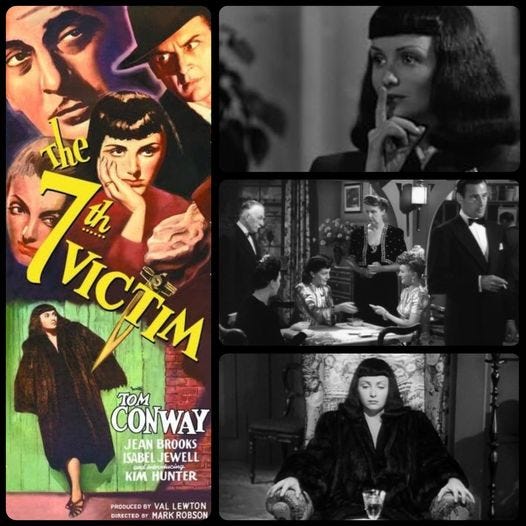THE SEVENTH VICTIM (Mark Robson, 1943) may be my favourite Val Lewton film, even if his undisputed classic is Cat People, which, by the way, is signified as continuous from The Seventh Victim, given that Tom Conway, brother of George Sanders, plays Doctor Judd in both and dies in the latter.
The film deals with Mary Gibson (Kim Hunter of Planet of the Apes and A Matter of Life and Death fame, in her screen debut) searching for her missing sister Jacqueline (Jean Brooks) and uncovering a Satanic cult in affluent New York society, which induces those who divulge its secrets to suicide.
Like most of Lewton’s films, The Seventh Victim is dense with horror film aesthetics, such as its stark chiarosuro photography, meaning, symbolism, and subversion of rules, conventions, and all that 1943 audiences might expect.
Our heroine, for instance, is surrounded by inexplicit but signified homosexual attractions. This appears to have no narrative motivation except to subvert the Hays code, which this film does a lot.
In other acts of subversion, the film portrays, without consequence, an emerging romance between Mary and her sister’s husband; and Doctor Judd’s client ethics are transparently absent without punishment.
Perhaps the greatest subversion, given that this film is about people escaping from controlling, Satanic cults, is the parallel that is offered when Mary escapes her school. Was it Lewton or Robson’s intention that the school be subtly signified as its own version of a controlling society—as a simile of the Satanic cult—when the headmistress’ assistant pleads with Mary to never return?
Among the film’s other symbols and signifiers, we meet a one-armed lady in the cult who symbolises that, in some way, the Satanists have lost some important part of themselves, but we never learn who she is or how she lost the arm. Of course, we don’t really need to know, but we are curious.
The fim’s ultimate act of subversion is, of course, its bleak nihilism. As it is in other Lewton films, death is the only escape, and as such, the film finishes on vain destruction rather than uplifting resolution.
Of course, much of the style and many of the devices in The Seventh Victim, such as the long night walk sequence with sound shocks, was not original with this film. It was creative, stylistic ground that had already been broken in Cat People, but it is done as well here as in any other example.
The film’s themes are also not new. Recurring and reliable, we confront those familiar Lewton themes of science versus belief, closed societies and outsiders, and, as mentioned, death as the only ultimate escape.
In its brief, tight run time of just 72 minutes—I confess, I like short films and the economy it inspires—so much is packed in without undue hurry. We still get to pause and savour the tension of the film’s various suspenseful sequences, such as the landmark sequence in which Mary and the private detective who decides to help her enter Jacqueline’s cosmetics factory at night, and the delightfully Hitchcockesque subway sequence which follows.
The film poses and refuses to answer many questions. How the one-armed lady lost her arm was already mentioned. What about the other Satanists? Who are they? What are they trying to achieve? How did they, and especially Jacqueline and the ladies of the cosmetics factory, come to join a Satanic cult?
For all my admiration of the film’s tightness and brevity, it commits a narrative cardinal sin: the over-eager editing removed a scene crucial to us knowing how the cult finds Jacqueline to kidnap her for the film's dramatic final act.
To counter that, I applaud the editing of the ending, with its refusal to mope and labour on the fim’s meaning and bleak message. Endings should be tight and this one is. It is something that Hollywood has forgotten.
Roy Webb’s memorable and evocative score is also a favourite.
I’ve recently spoken about how much I admire studious film criticism that helps us explore movies even more than we can explore them alone. To that end, I must credit Steve Haberman in his audio commentary, for guiding me as a viewer and helping me see more than I had seen before.
On the new Criterion Collection 4K disc and Blu-Ray release of this with Lewton’s I Walked With A Zombie, with which many parallels can be seen, I’m also grateful to the audio supplements telling the amusing stories of Tom Conway and the desperately tragic story of Jean Brooks.




